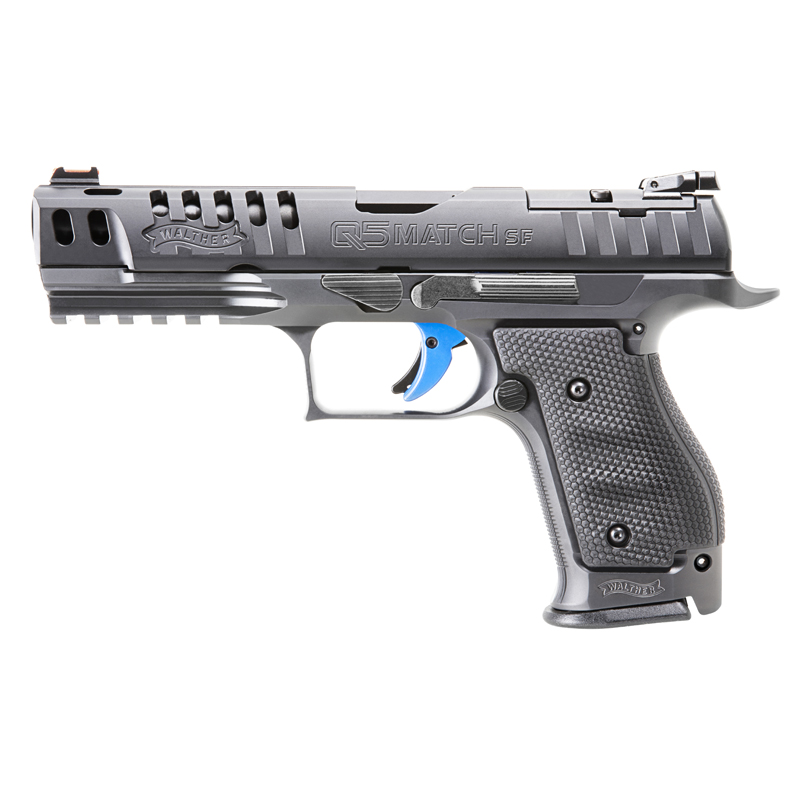Some Black Friday/Cyber Monday deals came together to make the CZ P-09 Carry Optics build previously discussed a plausible winter project, even on my reduced homeowner-with-projects budget.
Donor Gun: P-09 9mm
There were some amazing deals on 9mm P-09s over the post-Thanksgiving weekend. I scored one for $389, shipped and transferred. That would be a good price even for a much less good gun.
There’s at least one obvious difference between the C-Zed lower and this new one, and that’s the trigger. The new one has a much less aggressive curve. The trigger also feels better out of the box: parvusimperator and I agree it has much less grit and much less creep, although the trigger scale indicates that it has the same weights as the first lower did pre-tuning (4.5lb single action, above the top of the scale for ~10lb double action).
Another difference, on close inspection, is that the extractor pin appears to be stainless on the new slide. On the old slide, it shared the same finish as the slide itself. The markings are also different, but that’s to be expected. (The old gun’s serial number starts with B; the new one starts with C. I expect that accounts for many of the differences.)
It came with two magazines, so I have another two handy. I could technically shoot it in Production now that I have six magazines in total, but I would have to shoot .40 (the only slide I have with irons) and put the original baseplates back on the magazines (so the gun fits in the Production box). Competitive in three divisions is about the most you can get out of any one gun without using Limited 10 as a cheat, so I’m happy with that.
The CZ Custom followers work just as well with 9mm as they do with .40, and the fully-kitted 140mm magazines hold 23 rounds, which is again competitive with the best in the division.
If I want to shoot Limited and Carry Optics in the same day, I have to change two things about the gun: swap the safety for the decocker, since Carry Optics prohibits cocked-and-locked starts, and remove the magazine funnel, which is not permitted in Carry Optics. Both are easy enough to do at the safe table, although the safety-to-decocker swap omits the decocker return spring. (It isn’t a required part, as it turns out, and is extremely fiddly to get into position without a workbench, a decent light, a vise, and a selection of screwdrivers for prodding.)
Sight: Vortex Venom
Mounting Solutions Plus had free shipping and a 15% off deal on the Vortex Venom sight. It ran me $196.
The Venom occupies the same budget class as the Vortex Viper and the Burris FastFire, all of which come in at about the same cost. Parvusimperator recommended Vortex for their warranty, which amounts to, “If it ever breaks, we’ll fix it.” That’s a good thing to have on your competition pistol, where the sight will likely see thousands of rounds on a much faster schedule than your average carry gun.
The Venom also has a top-loading battery, which means I don’t have to remove the sight to replace the battery, which means less re-zeroing, which is good. Unfortunately, it uses CR1632 batteries, which means I’m now stocking 2032, 1620, and 1632 for the various sights on my guns. Happily, little coin cells are cheap.
There are plenty of cheaper micro-dots available, but slide-mounted sights have to take a lot of punishment, and this is a case where my usual budget-mindedness goes by the wayside.
One problem is that, at my minimum-advisable-cost $200 budget, there aren’t many options for sight window size. The Burris FastFire is the smallest of the bunch at 21mm by 15mm. The Viper is the tallest by a bit more than a millimeter at 24mm by 17.5mm. The Venom is the widest, at 26.3mm by 16.3mm. Forum posters suggest that it’s very hard to notice a difference of a few millimeters.
I found a forum post with a list of sights and window sizes, which is reproduced here, along with a street price column a column indicating millimeters of window height per hundred dollars. (The width is less important; given a good grip, it’s easy to bring a pistol onto target side-to-side, and less easy to get the elevation just right.)
For the area column, the sights are assumed to be rectangular (except for the C-More SlideRide, which is circular), which is an invalid assumption, but you get what you pay for.
| Sight Name | Width (mm) | Height (mm) | Area (mm2) | Street Price | mm height/$100 |
|---|
| C-More SlideRide | 29.0 | 29.0 | 660.52 (circle) | $300 (aluminum) | 9.667 |
| Vortex Viper | 24.0 | 17.5 | 420.00 | $230 | 7.608 |
| Vortex Venom | 26.3 | 16.3 | 428.69 | $230 | 7.087 |
| Burris FastFire III | 21.0 | 15.0 | 315.00 | $230 | 6.522 |
| JP JPoint | 21.5 | 15.0 | 322.50 | $285 | 5.263 |
| Sig Romeo 3 | 25.0 | 21.0 | 525.00 | $400 | 5.250 |
| C-More RTS2 | 25.0 | 22.0 | 550.00 | $420 | 5.238 |
| Sig Romeo 1 | 30.0 | 16.0 | 480.00 | $325 | 4.923 |
| Leupold DeltaPoint Pro | 25.7 | 17.5 | 449.75 | $370 | 4.730 |
| Vortex Razor | 27.8 | 17.4 | 483.72 | $400 | 4.350 |
| Trijicon RMR | 22.0 | 16.0 | 352.00 | $500 | 3.200 |
Except for a few outliers, like the big C-More and the tall micro-dots (the Romeo 3 and RTS2), it’s pretty much a list in order of increasing price. The RMR comes out looking bad, but it’s built for durability as much as anything else, and obviously that isn’t factored in here.
Mount: Springer Precision Dovetail Mount
I could have sent the slide off to Cajun Gun Works to be milled to accept a sight, but that’s a big expense, not just in terms of gunsmith time but also in terms of shipping. Much better to try a dovetail mount first. Springer Precision makes one. It cost $51 including shipping.
It seems to me to be a pretty good product. It’s held in place by four set screws, two in the dovetail and two nylon-tipped jobbers pressing against the top of the slide. We’ll see how it holds up in practice.
Notably, dovetail mounts position the sight much higher above the slide than milled mounts. A milled mount by necessity puts the base of the sight below the top of the slide, while a dovetail mount by necessity puts the base of the sight above the top of the slide. It doesn’t make the zeroing process very much more interesting. The sight rides about 1.15 inches above the bore, and a 25-yard zero is just as good as always for 9mm.
Slide Parts
A Cajun Gun Works extended firing pin, firing pin retaining roll pin, and firing pin plunger spring come to $43. The first two are required parts for the low-power springs in the C-Zed’s frame. The third is a trigger enhancement.
In Sum
I spent $679 on parts to turn the C-Zed into a convertible two-division gun. I probably could have done it cheaper if it weren’t for the inability to buy CZ slides on their own.
One thing I’ve noticed is that the balance of the gun is better now. Without the sight, an empty P-09 is nose-heavy. With it, the balance point is right at the back of the trigger guard.
Without any range time to back me up, I’m happy with the result. I’ll have more to say once I’ve burned some powder and, perhaps, shot a match or two in the spring.

